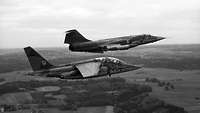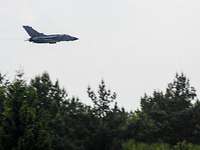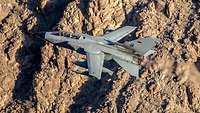Alaska almost at eye level. Low-flying Tornado aircraft during Pacific Skies
Alaska almost at eye level. Low-flying Tornado aircraft during Pacific Skies
- Date:
- Place:
- Alaska
- Reading time:
- 4 MIN
It is not without reason that military low-level flying is regarded as one of the most complex aerial warfare tactics. Why does the Air Force use these risky maneuvers and what are the particular challenges pilots find themselves facing?
Why does the Air Force use low-level flight?
Low-level flight is one of the elementary skills of military aviation. Depending on the threat situation – which will differ in asymmetric and symmetric conflicts, for instance –, low-level flight allows own forces to remain undetected under the cover of the terrain for a longer period of time than flight at medium or high altitudes, especially if the enemy has efficient airspace surveillance and air defense. The aim is obvious: to circumvent enemy countermeasures in order to be able to prevail more easily against the enemy forces. This is called robustness and survivability. Particularly in our orientation towards national and collective defense, low-level flight therefore plays a highly significant role.
What are the challenges pilots are confronted with?
Low-level flight is characterized by low altitudes, i.e. close proximity to the ground, combined with high speeds. This demands that the crews are fully concentrated, conduct disciplined cross-checks and enter precise control inputs since the smallest errors can result in contact with the terrain and thus have fatal consequences. The high speeds involved only allow for short periods of time for perception, orientation and reaction. This makes navigation more difficult. Meticulous preparation and a good knowledge of the routes chosen help to prevent unpleasant surprises. Moreover, the aircraft usually operate as a formation to achieve combined weapons effects, which is even more demanding at low altitudes. The individual aircraft of the formation are often less visible to eyes seeing them against the backdrop of the terrain. For this reason, the Air Force uses technical systems that assist the crews in maintaining a high situational awareness.
Why does the Air Force train low-level flight in Alaska?
Any terrain will interfere with lines of sight, both in the optical and non-optical electromagnetic spectrum, which in turn defines radar horizons and radar shadows. Thus, the physical characteristics of the terrain produce effects we want to make use of in military aviation. This is why Alaska, with its flat and mountainous areas, is particularly suitable for this type of low-level flight training. In addition, as it is a sparsely populated federal state, there are fewer civilizational factors and attendant conditions which have to be taken into account, such as a need to keep aircraft noise down or avoid structural obstacles such as masts, high-voltage lines and wind turbines. And finally, local standards permit low-level flying at significantly lower altitudes than in Germany, making Alaska as an overall package an excellent training area for the Air Force.
What is the role of modern aircraft technologies in this?
Modern technologies help our crews to focus on their essential tasks by maintaining a high situational awareness and reducing their workload. For instance, the on-board radar allows obstacles to be detected earlier, and modern navigation equipment provides a precise position fix without much effort. The interconnection of our aircraft makes it easier both to maintain the formation and to avoid threats from the air or the ground. Tornado aircraft have a terrain-following system that even makes automated low-level flying possible. In modern warfare, these tools are indispensable.

An Alpha Jet from Fighter Bomber Wing 49 Fürstenfeldbruck and a Starfighter combat aircraft in flight. Low-level flight training has been part of the DNA of fighter bomber units ever since the formation of the German Air Force in 1956.
Bundeswehr/Matthias Zins
A Tornado aircraft of the German Air Force in low-level flight. This jet aircraft was specifically designed for low-level flight operations above the North German Plain.
Bundeswehr/SchneiderWhat safety regulations apply?
Flight safety is of utmost importance to the Air Force, and safety precautions are implemented at all levels. During the exercise, the participants will heed the local requirements of the host nation as well as own national regulations – such as the Bundeswehr flight operations manuals with their clearly defined rules. If there are conflicting requirements of different regulations, the more restrictive ones will usually apply.
In addition, the Air Force operates in conformity with standardized procedures. For instance, the assignment of responsibilities or the communication within two-seat Tornado aircraft are clearly defined. In addition to regulatory and procedural certainty, good training is another essential component. This training takes place in the form of theoretical instruction in the simulator and naturally in real flight. With regard to Pacific Skies, all crews will complete a preparatory program and, depending on their level of experience, will be gradually introduced to the special challenges of low-level flight.



